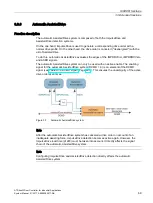
SIDOOR functions
3.3 Extended functions
ATD4xxW Door Controller for Industrial Applications
62
System Manual, 01/2017, A5E38080677-AB
3.3
Extended functions
Introduction
You can use the advanced features described below to implement application-specific
requirements.
3.3.1
ImpulseDrive
Description of function
The ImpulseDrive analysis process detects and evaluates external impulses applied to the
door system (for example, slight force exerted on the door in the opening or closing
direction).
In conjunction with the automatic ImpulseDrive system (see Section Automatic ImpulseDrive
(Page 64)), a heavy door can be set in motion by applying a slight force to the door handle or
door frame.
When the process detects an external impulse, corresponding status information (see Table
A-30 IMPDRVIncr signal (Page 295) and Table A-31 IMPDRVVelo signal (Page 295)) is
generated.
The ImpulseDrive detection properties can be individually parameterized to enable adaption
to different door systems.
Parameter assignment
The detection algorithm consists of a distance and a speed component. The sensitivity levels
of both components can be parameterized separately (p1221 and p1222). A parameterizable
lead time (p1220) is added to the detection algorithm to prevent problems caused by the
spring effects of sealing or rubber lips.
See Table 4-35 Calibration and function parameters (Page 179).
Note
Configuring ImpulseDrive detection directly affects the automatic ImpulseDrive, the
automatic AssistedDrive and the automatic AssistedStop system.
Requirements for ImpulseDrive detection
●
Parameters are matched to the target system
●
Controller is not in learn run
●
Drive command is "deenergize" ("DCMD := 0")
●
No obstruction has been detected in the detected direction of motion
Summary of Contents for SIDOOR ATD401W
Page 1: ......
















































